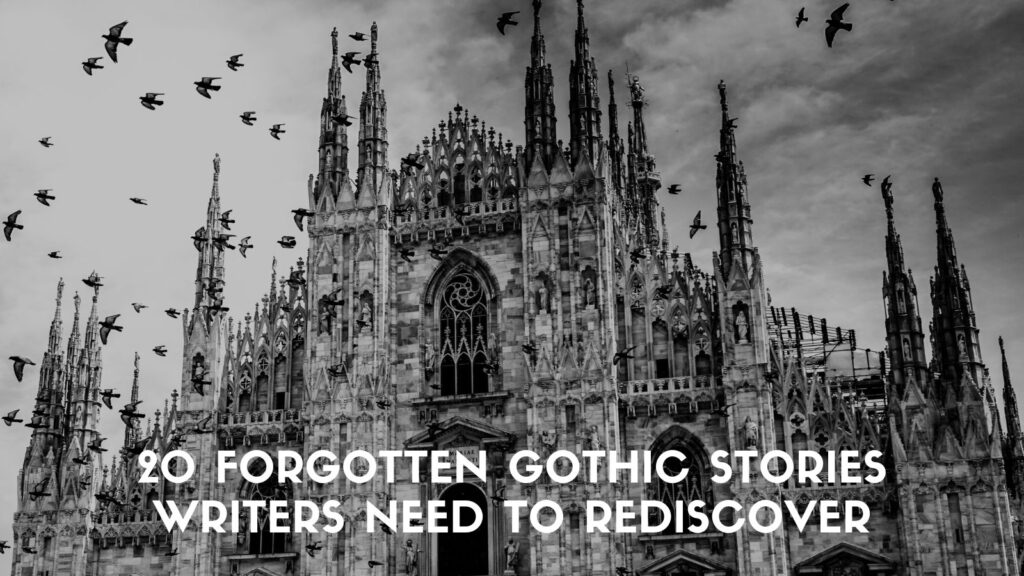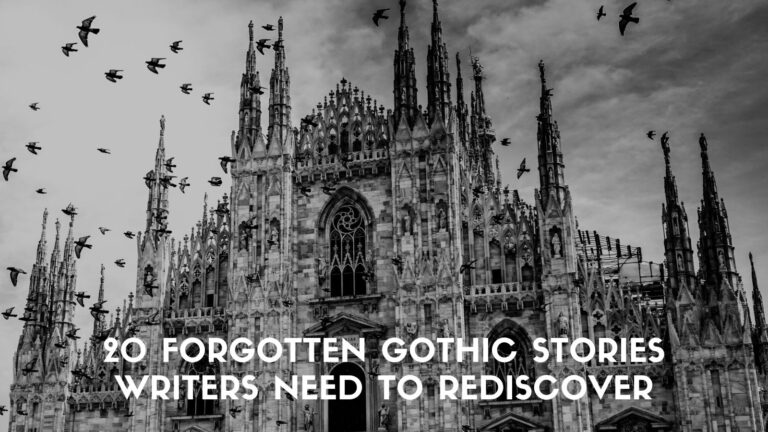
20 Forgotten Gothic Stories Writers Need to Rediscover
Oh my GOSH, let me tell you about my absolute OBSESSION with forgotten gothic treasures! While everyone’s always going on about Poe and Shelley (don’t get me wrong, I adore them too!), there’s this whole SECRET WORLD of lesser-known gothic stories that make my little heart race with delight!
I literally spend HOURS hunting through dusty bookshops and obscure online archives, finding these incredible stories that nobody talks about. It’s like discovering hidden manuscripts! Each time I uncover a new forgotten author, I brew myself a cup of tea, light some candles, and curl up in my reading nook as the wind howls outside. PURE BLISS.
These overlooked stories are absolutely DRIPPING with atmosphere – crumbling mansions, mysterious apparitions, psychological twists that’ll keep you up at night! What I love most is how each forgotten author brings their own unique flavor to the genre. Some focus on slow-burning dread that creeps up your spine, while others hit you with shocking moments that make you gasp out loud (I’ve definitely scared my cat more than once!).
What’s super fascinating is seeing how these stories reflect the fears of their time – whether it’s Victorian anxieties about science or post-war trauma wrapped in supernatural metaphors. I find myself frantically taking notes in the margins, inspired by their brilliant techniques that I NEVER see in modern horror.
I’ve put together this list of 20 ABSOLUTE MASTERPIECES that deserve so much more love! Trust me, once you dive into these stories, you’ll be texting me at midnight saying “WHY didn’t anyone tell me about these before?!” So grab your coziest blanket, make sure your doors are locked (just in case!), and join me on this journey through the shadowy corners of gothic literature that have become my second home. These stories aren’t just reads – they’re EXPERIENCES that will transform how you see the entire genre!
Here are the 20 Gothic Stories You Have to Read
- “The Beckoning Fair One” by Oliver Onions (1911) “The Beckoning Fair One” is a classic psychological horror novella that follows Paul Oleron, a writer who moves into an old, seemingly abandoned house to work on his novel. As he settles in, he begins to sense a female presence in the house that grows increasingly possessive. This entity gradually isolates him from the outside world, particularly from his loyal friend Elsie, who tries to rescue him from his deteriorating mental state. The story masterfully blurs the line between supernatural haunting and psychological breakdown, leaving readers uncertain whether Oleron is experiencing a genuine haunting or descending into madness. The ambiguity of the tale is its greatest strength, creating an atmosphere of creeping dread that builds to a disturbing conclusion.
- “The Shadows on the Wall” by Mary E. Wilkins Freeman (1903) “The Shadows on the Wall” is a chilling ghost story about three sisters and a brother who live together in their family home. After the sudden death of their brother Edward, the sisters begin to notice a mysterious shadow on the parlor wall that resembles Edward’s silhouette. Despite attempts to eliminate the shadow by moving furniture and adjusting lighting, it persistently returns. The surviving brother Henry becomes increasingly agitated by the shadow’s presence, suggesting his possible involvement in Edward’s death. The tension builds as the shadow serves as both an accusation and a manifestation of guilt, leading to Henry’s eventual demise as he succumbs to the psychological torment of the haunting presence. Freeman masterfully uses the supernatural element to explore themes of family secrets, guilt, and justice.
- “The Ghost Ship” by Richard Middleton (1912) “The Ghost Ship” is a whimsical and unconventional ghost story about a phantom pirate ship that mysteriously appears in a small English village far from the sea. One stormy night, a spectral ship crashes into the village, becoming lodged between buildings. The ghostly captain and crew begin to interact with the villagers, bringing their rowdy seafaring ways to the quiet community. Rather than being terrified, the villagers gradually accept and even embrace the supernatural visitors, incorporating them into daily life. However, the local rector disapproves of the ghosts’ disruptive influence. Eventually, after bringing both chaos and joy to the village, the ghost ship and its crew vanish as suddenly as they appeared, leaving the community to return to its former quiet existence, though forever changed by the experience. Middleton’s tale stands out for its blend of humor and the supernatural, subverting traditional ghost story conventions.
- “The Lost Ghost” by Mary E. Wilkins Freeman (1903) “The Lost Ghost” is a poignant supernatural tale told through a frame narrative where a boarding house owner recounts a haunting experience to her tenants. The story centers on a small ghost of a little girl who appears in the house, constantly searching and calling for her mother. As the narrative unfolds, it’s revealed that the child had been cruelly neglected and left to freeze to death by her mother. The ghost eventually finds comfort with two compassionate women boarders, particularly with Mrs. Meserve, who eventually dies and is seen leaving with the ghost child, having apparently become the loving mother figure the abandoned child had been seeking beyond death. Freeman’s story blends horror with profound emotional depth, exploring themes of maternal neglect, compassion, and redemption through its supernatural elements.
- “The Red Lodge” by H. Russell Wakefield (1928) “The Red Lodge” is a classic haunted house tale about the Bennington family who rent a countryside mansion for the summer despite local rumors about it being haunted. Shortly after moving in, family members begin experiencing disturbing phenomena—seeing shadowy figures, hearing strange noises, and feeling overwhelming sensations of dread. The young son Anthony is particularly affected, becoming withdrawn and frightened. As the supernatural occurrences intensify, the father discovers the house’s dark history of multiple suicides and violent deaths. The malevolent presence focuses its attention on Anthony, attempting to lure him to his death. The family ultimately flees the house, barely escaping with their lives. Wakefield’s story effectively builds tension through escalating supernatural events and explores how evil can persist in a physical location, affecting all who reside there.
- “The Upper Berth” by F. Marion Crawford (1894) “The Upper Berth” is a chilling maritime ghost story narrated by a character named Brisbane who recounts his terrifying experience aboard the steamship Kamtschatka. Brisbane is assigned to cabin 105, where he discovers the upper berth has a disturbing history—its occupants either disappear or are found dead. Despite switching to the lower berth, Brisbane experiences frightening phenomena: the porthole mysteriously opens despite being securely locked, cold seawater floods the cabin, and he encounters a dripping, ghostly figure climbing into the upper berth. After a near-fatal struggle with the entity, Brisbane refuses to stay in the cabin. It’s later revealed that a passenger had committed suicide by drowning himself from that cabin, and his spirit continues to haunt the upper berth, claiming new victims. The ship’s company eventually destroys cabin 105 to end the haunting. Crawford’s tale effectively uses the claustrophobic setting and isolation at sea to create an atmosphere of inescapable terror.
- “The Doppelgänger” by Dorothy Macardle (1928) “The Doppelgänger” is an atmospheric ghost story set in a small Irish village where the narrator, a teacher named Miss Meredith, takes up a position at a local school. She becomes increasingly disturbed when villagers claim to have seen her in places she hasn’t been. These sightings occur when she’s demonstrably elsewhere, creating confusion and suspicion. As the tale progresses, Miss Meredith discovers that her mysterious double appears to be the ghost of a previous teacher who died tragically and shares a striking resemblance to her. The doppelgänger’s appearances become more frequent and ominous, seemingly trying to lead Miss Meredith toward the same fatal end that the dead teacher experienced. The story builds tension through the protagonist’s growing fear and isolation as she struggles to understand whether she’s being haunted or losing her mind, culminating in a confrontation with her spectral twin.
- “The Haunted Dolls’ House” by M.R. James (1923) “The Haunted Dolls’ House” tells the story of Mr. Dillet, an antique collector who purchases an elaborate Queen Anne-style dollhouse from a reluctant dealer. After bringing it home, Dillet is awakened at night to witness a miniature supernatural drama unfolding within the dollhouse. The tiny scenes reveal a disturbing narrative: an elderly man is murdered by a sinister doctor and a female accomplice who administer poison, while a ghost-like figure appears to summon vengeance for the crime. The spectral drama concludes with the appearance of a small, shrouded figure that terrifies the miniature murderers. Dillet later discovers that the dollhouse is a precise replica of a real home where similar events occurred—the murder of its wealthy owner and the subsequent haunting that led to the deaths of the perpetrators. James masterfully creates horror through the uncanny animation of the miniature world and its connection to actual historical crimes.
- “The Wendigo” by Algernon Blackwood (1910) “The Wendigo” is a haunting wilderness horror story set in the remote forests of Canada. It follows a hunting party consisting of two guides (Défago and Hank), a doctor named Cathcart, and his nephew Simpson. When Défago and Simpson separate from the others to track moose, Défago becomes increasingly uneasy as night falls. In the middle of the night, Simpson witnesses something terrifying—Défago is called away by an otherworldly voice and disappears into the sky, leaving only his footprints in the snow. The footprints show evidence of enormous strides and signs of burning. When Défago eventually returns, he is fundamentally changed—speaking in an inhuman voice and describing how the mythical Wendigo forced him to run through the sky until his feet were burned away. Blackwood masterfully uses the vast wilderness setting to create a sense of cosmic dread, portraying the Wendigo as an elemental force that embodies the dangerous, primordial power of untamed nature..
- “The Tomb of Sarah” by F.G. Loring (1900) “The Tomb of Sarah” is a vampire tale centered around the mysterious tomb of Lady Sarah Sabiston in a rural English churchyard. The narrative follows Reverend Verney, who becomes suspicious of the tomb after noticing its unusual features and learning of local superstitions about Lady Sarah being a vampire. His concerns intensify when his friend’s daughter, Eliza, begins suffering from a mysterious illness involving blood loss and disturbing dreams about Lady Sarah. After consulting with a doctor who confirms the vampire theory, they discover that the tomb has been damaged, allowing Lady Sarah to escape at night. The men decide to confront the vampire using traditional methods—opening the tomb to find Lady Sarah’s perfectly preserved corpse, which they stake through the heart and then burn. Their actions save Eliza, who gradually recovers from her ordeal. Loring’s story follows classic vampire folklore traditions while creating a distinctly English setting for the supernatural threat.
- “The Derelict” by William Hope Hodgson (1912) “The Derelict” is a maritime horror story about a ship’s crew that discovers an abandoned vessel covered in a strange fungal growth floating in a patch of seaweed-filled water. When they board the derelict to investigate, they find it completely overtaken by a slimy, pulsating organism that seems to be gradually consuming the entire structure. The explorers realize with growing horror that this organism is not just feeding on the ship but transforming it into something alive and malevolent. As they attempt to leave, the entity becomes aggressive, forcing them to fight their way back to their own vessel. They ultimately escape and destroy the derelict with gunfire, causing it to sink back into the ocean depths. Hodgson masterfully combines nautical adventure with cosmic horror, presenting the derelict ship as a nightmarish fusion of organic and inorganic matter that challenges the boundaries between life and non-life.
- “The Haunted and the Haunters” by Edward Bulwer-Lytton (1859) “The Haunted and the Haunters” tells the story of an unnamed narrator who, upon hearing of a supposedly haunted house in London, decides to spend the night there with his servant and faithful dog. Inside, they experience escalating supernatural phenomena—furniture moving on its own, phantom footsteps, ghostly apparitions, and terrifying visions. The narrator discovers that the hauntings are connected to a centuries-old mesmerist and sorcerer who has unnaturally extended his life and uses the house as a psychic battery for his powers. The haunting is revealed to be orchestrated through a small object hidden in a secret room. When the narrator removes this talisman, he breaks the sorcerer’s power over the house. The story stands out for its blend of traditional ghost story elements with pseudo-scientific explanations, presenting the supernatural as a manifestation of unknown natural forces rather than purely spiritual phenomena.
- “The Pale Man” by Julius Long (1934) “The Pale Man” is a suspenseful horror story set in a nearly empty hotel where the narrator notices a mysterious, unnaturally pale man staying in a room across the hall. Each day, the pale man’s room appears to move closer to the narrator’s, though the hotel clerk insists no such guest exists. The narrator becomes increasingly disturbed by this impossible phenomenon, especially when he notices the man watching him constantly. In a final terrifying revelation, the narrator discovers the truth: the pale man is actually Death itself, who has been gradually approaching to claim him. The story ends with the chilling implication that the narrator’s time has run out as Death has finally reached his door. Long masterfully builds tension through the uncanny premise and the inexorable approach of the supernatural figure, creating a memorable meditation on the inescapability of death.
- “The Kit-Bag” by Algernon Blackwood (1908) “The Kit-Bag” is a ghostly tale about Johnson, a law clerk who has been working on a gruesome murder case where the defendant, Henry Mandeville, is acquitted despite strong evidence of his guilt. After the trial ends, Johnson plans a skiing holiday and borrows a kit-bag from his employer. Alone in his apartment on Christmas Eve, Johnson experiences increasingly terrifying phenomena centered around the kit-bag—strange noises, movement, and ultimately the manifestation of what appears to be the murder victim’s distorted face emerging from the bag. The story suggests that either the vengeful spirit of Mandeville’s victim has attached itself to an item connected to the trial, or that the evil essence of Mandeville himself has somehow contaminated the bag. Blackwood creates a sense of mounting dread through the contrast between Johnson’s anticipation of a pleasant holiday and the intrusion of supernatural horror into his ordinary life.
- “The Moonlit Road” by Ambrose Bierce (1907) “The Moonlit Road” is a haunting tale told from three distinct perspectives about a mysterious murder. First, a son named Joel Hetman Jr. recounts how his father summoned him home after his mother’s strangulation by an unknown intruder. Later, the father disappears after claiming to see his dead wife’s ghost on a moonlit road. The second perspective comes from the missing father, who confesses through a medium that he strangled his wife in a jealous rage, then fled when he encountered her ghost. The final narrative is from the murdered wife’s spirit, who exists in a confused state between life and death, unable to fully comprehend her own murder or recognize her husband as her killer. Bierce masterfully employs these multiple viewpoints to create an unsettling story about guilt, perception, and the fragmentary nature of truth, leaving readers to piece together the complete narrative from these interconnected but limited accounts.
- “The Screaming Skull” by F. Marion Crawford (1908) “The Screaming Skull” is a psychological horror story narrated by Captain Charles Braddock, who lives in the coastal home where his cousin’s wife Julia was allegedly murdered. The cousin died shortly after his wife, leaving Braddock to inherit the property and a mysterious skull that he claims screams at night. As Braddock tells his tale to an overnight guest, he reveals his increasingly disturbed mental state and his obsession with the skull, which he believes contains Julia’s vengeful spirit. Braddock insists the skull is responsible for his cousin’s death and fears it seeks revenge on him next. Throughout the narrative, it remains ambiguous whether the skull actually screams or if Braddock is descending into madness driven by guilt—suggesting he might have been involved in Julia’s death. The story concludes with the implication that the skull will soon claim Braddock as its next victim.
- “The Dead Valley” by Ralph Adams Cram (1895) “The Dead Valley” is a tale of cosmic horror told by a Swedish man recounting his childhood encounter with a mysterious and unnaturally desolate valley. While exploring with his cousin Nils, they discover a hidden valley utterly devoid of life—no plants, animals, or insects exist there. The valley emanates an inexplicable sense of dread and features an eerie physical characteristic: absolute silence and a strange atmospheric pressure that prevents sound from traveling. When Nils ventures too far into the valley to retrieve their dog, he becomes trapped by an invisible force field at its center. The narrator watches in horror as Nils slowly suffocates and dies, unable to hear his screams or reach him. The story concludes with the suggestion that the valley is an ancient, malevolent entity that periodically claims sacrifices. Cram creates a profound sense of cosmic dread through the depiction of a landscape that defies natural laws and exists as a sort of wound in the natural world.
- “The Shunned House” by H.P. Lovecraft (1924) “The Shunned House” follows the narrator and his uncle Dr. Elihu Whipple as they investigate an abandoned house in Providence with a disturbing history of illness, madness, and death among its occupants dating back to the 1700s. After extensive research, they discover that the house harbors a malevolent entity—a vampiric being rooted in the cellar, feeding on the life force of those who live above it. This parasite manifests as phosphorescent vapor and strange fungoid growths. The pair decide to confront the entity directly by spending a night in the cellar armed with scientific equipment and chemical weapons. During their vigil, they witness the entity take physical form, which causes the uncle’s death. The narrator ultimately destroys the creature by dousing it with acid, revealing a massive, misshapen skeleton beneath the house’s floor. The story blends traditional haunted house elements with Lovecraft’s cosmic horror, presenting the entity as neither ghost nor conventional monster, but something more primordial.
- “The Ghost Garden” by Elizabeth Bowen (1928) “The Ghost Garden” is a subtle supernatural tale that takes place at a rural Irish estate called Kewellin where young Kathleen is visiting her grandparents. She discovers a walled garden where she has an unsettling encounter with a mysterious boy dressed in old-fashioned clothing. The adults reveal that the garden has a disturbing history—during a previous generation, a child disappeared there under strange circumstances and was never found. The story suggests that Kathleen has encountered the ghost of this long-lost child, who appears to be trapped in a timeless loop within the garden space. Bowen’s narrative is distinguished by its atmospheric quality and psychological depth rather than overt horror, exploring themes of childhood innocence, the persistence of the past, and how certain spaces can become repositories for traumatic events that echo through time.
- “The Dolls’ Castle” by Elizabeth Bowen (1939) “The Dolls’ Castle” is a subtle ghost story about two young sisters, Vivien and Joyce, who discover an old dollhouse in their attic that once belonged to their deceased aunt. As they play with it, they begin to sense a strange presence, particularly around a peculiar doll that doesn’t match the others. The girls gradually realize that when they arrange scenes in the dollhouse, parallel events occur in the real house, suggesting an uncanny connection between the miniature world and reality. The story hints that the spirit of their dead aunt somehow inhabits or influences the dollhouse, using it to communicate with or manipulate the living world. Bowen creates an atmosphere of gentle unease rather than outright terror, exploring themes of childhood imagination, family connections across time, and the ways in which objects can retain emotional imprints of their previous owners.
Why Writers Should Rediscover These Stories
- Fresh Perspectives: These forgotten tales offer unique approaches to gothic tropes, inspiring new twists on classic themes.
- Diverse Voices: Rediscovering these authors brings diverse perspectives to your gothic influences.
- Craft Lessons: Each story showcases different techniques in atmosphere-building, character development, and narrative structure.
- Historical Context: Understanding the evolution of gothic fiction can inform and enrich your own writing.
- Inspiration for Innovation: These stories can spark ideas for pushing the boundaries of contemporary gothic fiction.
How to Incorporate These Rediscovered Stories into Your Writing Practice
- Analytical Reading: Don’t just read for pleasure. Analyze the techniques these authors use to create fear, suspense, and atmosphere.
- Writing Exercises: Try rewriting a scene from one of these stories in your own style, or use elements from them as prompts for your own work.
- Genre Blending: Notice how these stories often blend gothic elements with other genres. Experiment with similar fusions in your writing.
- Character Studies: Examine how these authors create memorable, complex characters within the gothic tradition.
- Setting as Character: Many of these stories excel at making the setting a key element. Practice describing locations with the same depth and menace.
Conclusion: Unearthing Gothic Treasures
Diving into these forgotten gothic stories isn’t just about adding to your TBR pile—it’s about finding ACTUAL MAGICAL DOORWAYS into different corners of gothic storytelling! Each one of these overlooked treasures gives you this totally unique experience that the mainstream classics just can’t provide. I’ve spent COUNTLESS nights wrapped in my favorite blanket, notepad by my side, completely LOSING MY MIND over some brilliant psychological twist or atmospheric description!
The techniques these underappreciated authors use are just chef’s kiss! Pay attention to how they slowly build this creeping dread that follows you even after you put the book down. I literally had to sleep with the lights on after reading “The Upper Berth”—the way Crawford makes you FEEL the cold, wet presence in that steamship cabin?! CHILLS. These writers are absolute MASTERS at creating unease with just a few carefully chosen words.
What’s absolutely FASCINATING is seeing how these stories capture different historical anxieties—like how Victorian ghost stories often deal with repression, or how post-war tales reflect collective trauma. When you understand this evolution, your own writing becomes part of this grand, spooky tradition! I’m constantly thinking about how MY stories connect to this gorgeous, terrifying tapestry.
Don’t just passively read these stories—DEVOUR them! Ask yourself “why am I suddenly afraid to look in the mirror?” or “how did they make an ordinary house feel so threatening?” Take notes! Dog-ear pages! (Sorry, librarians!) Imagine how these forgotten authors might have changed EVERYTHING if they’d been properly appreciated in their time!
Let these overlooked MASTERPIECES seep into your bones and haunt your dreams (in the best possible way!). Their whispers from the past might just inspire your next midnight writing session. Now excuse me while I make another pot of tea and return to my reading nook—there’s a particularly spine-tingling story calling my name! Happy exploring, and may these rediscovered treasures follow you home, inspiring you to write stories that will have readers checking under their beds for generations to come!
- How to Edit your poetry for beginners and beyond (with worksheet) - April 18, 2025
- 20 Forgotten Gothic Stories Writers Need to Rediscover - April 18, 2025
- The Writer’s Roadmap: Embracing Outlining (Free Worksheet Included!) - April 15, 2025






